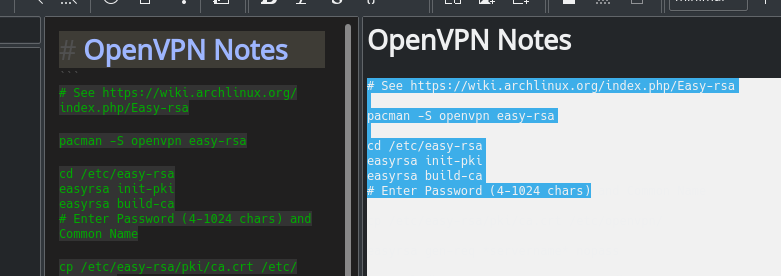
It has the notes list on the left hand side of the screen and then the main note body to the right. Opening up the program to start with, it was similar to nValt, but perhaps not quite as simple as I might like it.
#Qownnotes dark theme free
Free and open source, which was a good sign, I downloaded it in the hope if would be the text editor I was looking for. So during my browsing on Alternativeto, I managed to come across QOwnNotes that seemed to promise the nValt experience I was after. There’s also nvPy which is a Python implementation of nValt, but again this syncs with Simplenote and I really don’t need this feature, I just want the files saved locally where I want to save them. There’s Resophnotes for example, however, this syncs using Simplenote and doesn’t save files locally as Markdown files (but that’s perhaps me being picky). I’ve occasionally tried to find different editors that will do the job of nValt. Overall, I’ve been able to write blog posts as and when I’ve needed to and I’ve been able to use it fairly successfully, but it’s never been as straight forward and easy to use as nValt, which is a shame. Basically this recommends a few plugins, such as Advanced New File (and a few other search ones, but I’ve basically not installed these on my recent version and I’ve noticed no difference). I’ve installed a few Sublime plugins to try and help replicate nValt slightly, using the article I found here. In general, this has worked reasonably well.
#Qownnotes dark theme windows
On Windows and Linux, this has usually been by using Sublime Text or Atom 1. However, jsut for notes and short notes (or even longer items), I continued to use plain text. Since then however, I’ve discovered Zim Wiki and I use that for storing my data that where I may need images, as at the end of the day, it saves data as a text file still, so I’ll be able to access it at a later date wherever. It worked well and I preferred it to Evernote. I used that (rather than Notational Velocity) for a number of years for storing notes and stored everything in it from blog posts, to research notes and paper reviews. Finally, export to markdown is paywalled.One of the few programs I really miss from macOS is nValt. no ‘raw’ view) you can only edit using the WYSIWYG. Secondly, there’s no easy way to edit markdown as text (i.e. Sadly I do find that UpNote’s “Markdown support” - touted as a key feature, no less- a little caveat-y.įirstly, not all of Markdown’s features are supported (including tables, footnotes, superscript 1, emoji, auto-URL creation). UpNote does have a couple of cute features of its own, like being able to set a custom image for covers of notebooks an easy-to-access version history for all notes and a toggle to enable an ‘always on top’ option (which is handy when transcribing notes from other apps).Īnd if you’re willing to pay you can access a variety of different themes and fonts – perfect for creating a “workspace” that feels entirely to your vibe. If you’ve read all of that preamble and you’re still interested, then UpNote does, at first blush, appear like a well designed and capable application able to provide some competition to tools like Microsoft OneNote and Evernote:


The service does offer a free tier that lets you create “up to” 50 notes using basic features but you will need to shell out $0.99/month subscription (or pay a $19.99 one off fee) to create more than this, and unlock advanced options like tables, attachments, and extra export options. Now, I will mention upfront that the UpNote Linux client is Electron-based, and it is closed-source, proprietary software. If you’re yet to settle on a note-taking service that works across platforms you may want to check out a new option now available for Linux: UpNote.


 0 kommentar(er)
0 kommentar(er)
